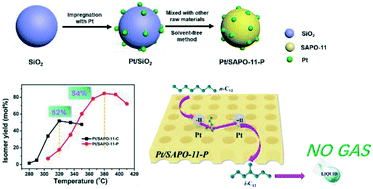Design of Pt/SAPO-11 bifunctional catalyst with superior metal–acid balance constructed via a novel one-step pre-loading strategy for enhancing n-dodecane hydroisomerization performance†
Abstract
A novel metal preloading route is proposed to prepare Pt/SAPO-11 bifunctional catalysts. The addition of platinum brings about an increase in catalyst product yield with a growth rate of 87% attributed to chemical adsorption between Pt and the lone pair of electrons in the nitrogen atom of the structure-directing agent. More interestingly, it can be concluded from the HAADF-STEM, SE-STEM images and DRIFTS data on CO adsorption, there are small Pt nanoparticles confined inside the SAPO-11 molecular sieve, while the big Pt nanoparticles are dispersed on the surface. The synergistic effect between the metal sites and acid sites can be improved by the enhancement of metal–acid balance, by adjusting the nPt/nA ratio. A better metal–acid balance property is achieved and the carbenium ion can quickly go through the hydrogenating reaction on Pt nanoparticles, hence shortening the time it is trapped in the acid sites upon n-dodecane hydroisomerization. Consequently, the cracking reaction can be effectively avoided and liquid yield as high as 99% and isomer yield up to 84% is produced, much superior than the Pt/SAPO-11 catalyst synthesized via the traditional impregnation method of Pt with the maximum isomer yield of 52%. Moreover, more multi-branched isomers are produced and can further help improve the low-temperature rheology when used as lubricant base oil.



 Please wait while we load your content...
Please wait while we load your content...